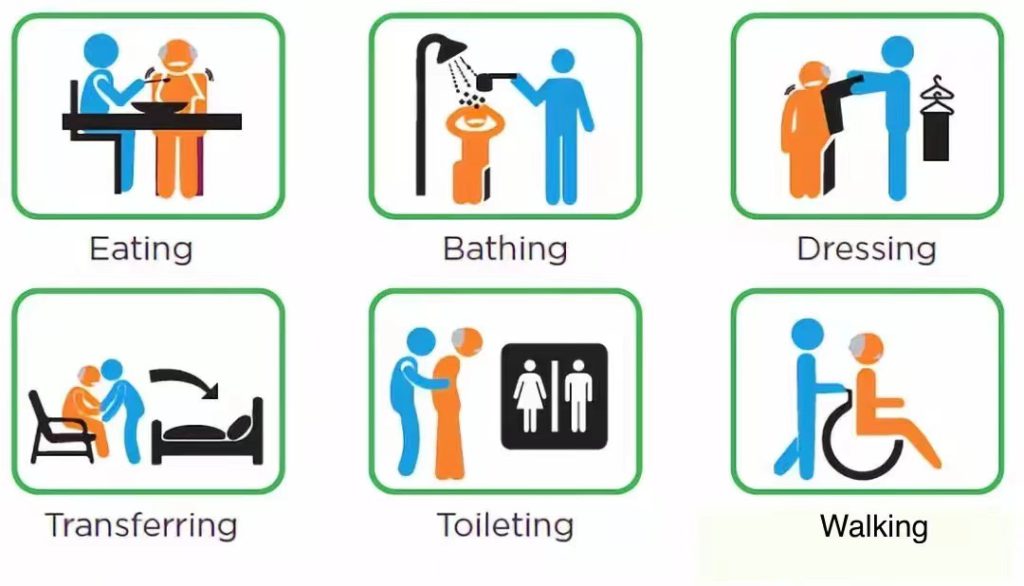在insurGuru©️寿险学院之前的教程里,美国人寿保险指南网介绍了美国保险行业用“保单+附加条款”的搭配设计,来为投保人提供更多保障和福利的基本原理。
在现实生活中,一些人寿保险公司的保单会提供 慢性疾病附加条款,或者 长期护理附加条款 供投保人选择。在美国人寿保险市场上,单独的长期护理保险,也是一个常见的销售险种,主要用于退休后的看护需求。
在投保过程中,面对不同公司,不同市场人员的各说一辞,关注“赔付护理费用”这个问题的投保人往往会感到极大的困惑。
那美国保险行业中的“长期护理保险” 和 “慢性疾病赔付”,这两者有什么区别?它们是怎么被加到保单里去的?哪些需要额外付钱?我们到底该买哪一个才能赔付护理费用?哪一个更适合?美国人寿保险指南网邀请寿险专栏作家Heather撰写了这篇文章,对这个问题进行了说明。

长期护理保险 是什么?
长期护理保险,英文称为Long Term Care Insurance,是美国市场上的一个保险产品,它用来帮助支付“长期护理“这项服务的相关费用。
这款保险产品在上个世纪70年代末期出现,但当时并无太大市场反响。直到80年代末期90年代初,由于平均寿命的提高,家庭看护,成人日间看护,以及生活辅助社区的兴起,带动长期护理保险成为了当时的“必需品”。
长期护理保险的保单在申请时,会约定以下面3种方式进行赔付:
- 如果符合赔付条件,受保人需要长期护理服务,那么保险公司赔付这笔服务的费用。这是目前长期护理保单最主要的赔付方式。
- 如果符合赔付条件,保险公司按照保单约定,赔付一笔定额的钱。它跟特定的看护服务费用或开销支出无关。
- 如果符合赔付条件,如残疾情况,即使没有用到长期护理服务,保险公司也定期支付赔偿金,如按天、周、月支付。
传统的长期护理保险 VS 新兴的混合型保单Hybrid
根据LIMRA的数据显示,2000年的时候,上述这类传统的长期护理(LTC)保险保单的年度销量达到750,000份。但到了2017年,这类传统的长期护理(Traditional LTC)保险的保单年度销量只有70,000份,市场销量骤降了90%。
这中间发生了什么呢?随着美国保险业的激烈竞争和相关法规的修订,“赔付护理费用”的福利,也终于被保险公司打包作为混合型人寿保单(Hybrid),或年金产品的附加条款,投入到了市场。
LIMRA同期的数据显示,在2017年里,带有“赔付长期护理费用”功能的的混合型人寿保单(Hybrid)年度销量达到260,000份,全美25%的人寿保单新增保费用来支付申请了这类产品。
市面上的人寿保险公司,主要通过以下3种方式,提供该福利:
- 使用“慢性疾病提前支取身故赔偿金附加条款(Chronic Illness Accelerated Death Benefit Rider / Chronic Illness Benefit Rider)”,来用于“赔付长期护理费用”。— 这种方式,就是我们通常说的“慢性疾病附加条款”。如果投保人满足合约理赔认定条件,保险公司向投保人按约定周期支付赔偿金,投保人可以支配这笔钱的用途1。这笔钱是从保单里的身故赔偿金里面拿出来的,因此,会降低保单的身故赔偿额度。同时,因为这笔钱是从保单身故赔偿金里“提前”取出来的,并没有“新”的钱出现,所以它不是,也不属于长期护理保险险种的概念认定。
- 使用“长期护理附加条款(LTC Rider)”,来用于“赔付长期护理费用”。— 这种方式,就是将传统的长期护理保险保单,作为附加条款,加入到一份人寿保单里,供投保者选配。长期护理附加条款通常以“报销“或“现金理赔”的方式,按月实际开销,进行理赔。这种方式,用于在投保时就购买一个保证和确定下来的长期护理理赔额度,通常这个长期护理理赔额度等于身故赔偿金。在长期护理赔金没用完的情况下,保险公司会继续支付,这是和“慢性疾病附加条款”赔付情况的一个重要区别,下文进行了详细描述。它通常是一个 收费 的附加条款,需要额外费用,只有部分人寿保险公司提供这种方式。
- 新型 Hybid 长期护理保险—这种方式,通常是一款人寿保险,或年金保险和长期护理附加条款的组合型保险产品。这类产品专一针对中老年人的长期护理需求。它结合了传统长期护理保险的优势和人寿保险的优势,既可以做到了终身的长期护理理赔,并且保费还能享受部分税务抵扣。
两种方式理赔认定条件的异同
从根本上来说,慢性疾病附加条款 和 长期护理保险 的理赔关键认定因素 是相同的。

慢性疾病赔付附加条款 和 长期护理保险 都是用 无法正常进行六种 “日常生活活动(ADLs)”中的活动数量(通常为两种),来作为赔付判断标准。
举例来说,有些长期护理保单,比如美国人寿保险指南网近期报道的,由华盛顿州政府运营的全民长期护理保险保单,其提案里就是用 无法正常进行六种 “日常生活活动(ADLs)”中的任意三种活动 来作为赔付判断标准。
而大多数提供慢性疾病赔付附加条款的美国人寿保险公司,则是以无法正常进行六种 “日常生活活动(ADLs)”中的任意两种活动 来作为赔付判断标准(具体细节以保单实际条款为准)。
作为投保者,在实际申请过程中,需要了解不同保险公司在不同州的具体赔付判断标准。
附加条款的优点和缺点
以“慢性疾病提前支取身故赔偿金”这样的附加条款进行理赔,理赔的金额是不确定的,并且由保险公司决定,这种方式,称为“折扣”的理赔方式。优点,则是便宜,通常是保险公司额外赠送在保单里面,并设置了最大理赔额度限制或比例限制。
以“长期护理附加条款”这样的附加条款进行理赔,理赔的总金额,在投保时,就是确定下来的。这是它用于“保障”的最大优势。市场上一些优秀的Hybrid长期护理保险,已经做到了终身理赔,理赔金额可以超过身故赔偿金额度,无上限赔付。
而对于退休一族来说,如果对长期护理有明确的需求,可以考虑专业用于长期护理的Hybrid长期护理保险。
( >>>推荐阅读:美国长期护理保险险种介绍 价格 优缺点 理赔必读 和购买年龄窗口)
insurGuru©️文章小结
为满足投保者关心的“长期护理费用赔付”的需求,美国保险市场上提供了不同的选择。本文从保单历史,功能发展,及市场实际销量数据等角度,展示了20年来,针对这个需求的行业发展情况和当前解决方案。传统的长期护理保险日渐式微,而以附加条款方式提供该福利的混合型人寿保单产品和功能更强大哦的Hybrid长期护理保单产品逐步赢得了市场。我们期待市场上能涌现出更多优秀的产品,为投保者带来更多的福利和选择。
(美国人寿保险指南网 insurGuru©️专栏)
附录
1慢性疾病赔付的条款和支取使用使用条件因不同保单和不同州的法律规定而不同。比如马萨诸塞州就规定,慢性疾病的提早理赔仅可用于合乎规定的长期护理服务。
*长期看护/长期护理,和长期看护保险/长期护理保险是两个不同的概念,前者指一系列服务,或行为,而后者是指特定保单产品。




